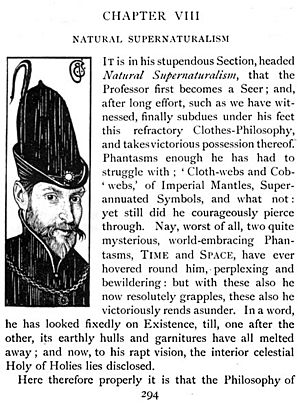Natural Supernaturalism facts for kids
Natural Supernaturalism is a big idea from Thomas Carlyle, a famous writer. It comes from a chapter in his book Sartor Resartus, written between 1833 and 1834. This idea is a main part of his character Diogenes Teufelsdröckh's "Philosophy of Clothes."
At its heart, Natural Supernaturalism means that everything around us is amazing. It suggests that life itself is full of wonders. These wonders can't be fully explained or removed by science.
Carlyle thought of this idea as a "new story" that fits with modern science. Instead of thinking a miracle is something that breaks nature's rules, Natural Supernaturalism says that nature and its rules are miraculous themselves. They are "infinitely deep" and "infinitely wide."
It means that miracles are just a deeper truth. Mysteries are parts of science we don't yet understand. And wonder is the base for all logic. It's about seeing the extraordinary in the ordinary.
What Carlyle Really Meant
Carlyle believed Natural Supernaturalism could fix mistakes from the the Enlightenment period. He wrote in his journal in 1833 that people in the past tried to make the amazing seem normal. But he wanted to do the opposite. He wanted to show that the normal is actually amazing.
He felt this idea was his "great Message" to the world. He believed it was so important that it had to be shared. He wrote that sharing this idea would make his life meaningful.
In 1852, Carlyle wrote about a "new kind of divineness." He said this special feeling wasn't from far-off places like Judea or Mount Olympus. Instead, it was inside every person, in their own heart.
Carlyle compared old ways of thinking about God (like theism) to the Ptolemaic model. This model said the Earth was the center of the universe. He compared Natural Supernaturalism to the Copernican model, which correctly showed the Sun was the center. Just as the Copernican system changed how we saw the universe, Natural Supernaturalism was a huge "revolution" in how we see our spiritual world.
How This Idea Influenced Others
Carlyle's idea of Natural Supernaturalism had a big impact. It influenced a group of thinkers called British idealism. One of them, James Hutchison Stirling, said Carlyle's chapter was the start of a "higher philosophy" in Britain.
Two American writers, Ralph Waldo Emerson and Henry David Thoreau, admired Carlyle. They were also inspired by this idea. Because of this, Natural Supernaturalism played a big role in American Transcendentalism. This was a movement that believed in the goodness of people and nature.
The term "Natural Supernaturalism" has also been used in literature. Writers like M. H. Abrams used it to discuss the works of authors such as Margaret Oliphant, Elizabeth Gaskell, the Brontë family, and William Shakespeare.
Images for kids



